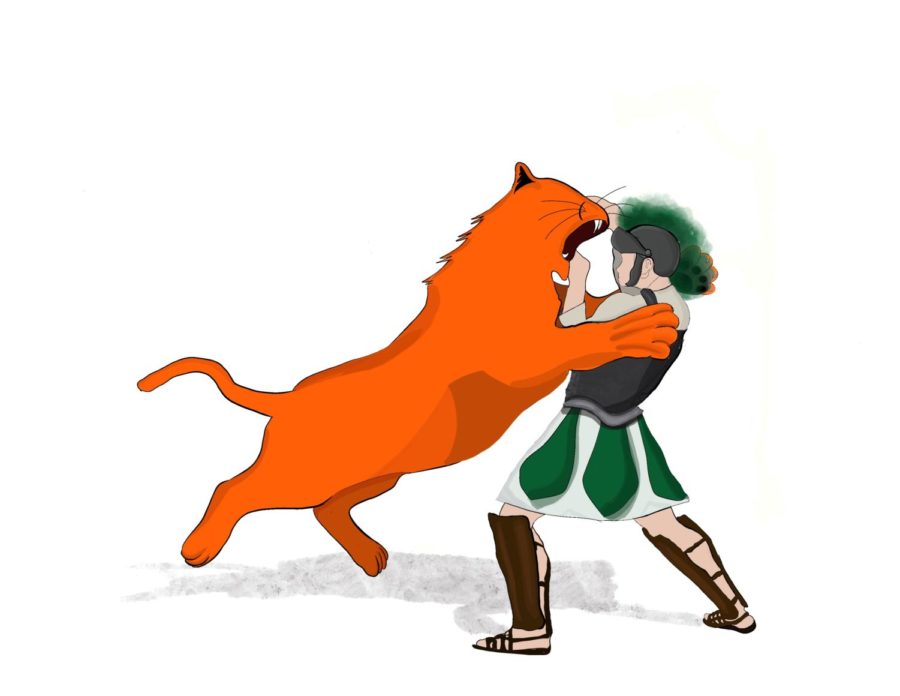ETHS, New Trier alums, students reflect on school rivalry
Illustration by Sabrina Barnes
Over time, the rivalry between New Trier and Evanston has shifted, but many of the underlying reasons for the divide remain.
From aggressive slogans and chants to hallway trash talk, almost every ETHS student has heard or voiced some bad things about New Trier.
This isn’t a new fixture; even after nearly half a century, the rivalry between ETHS and New Trier has remained intact. Those that attend Evanston Township have a preconceived notion of New Trier and vice versa. This conflict has sparked a thirst for knowledge, specifically in terms of its origin—what exactly is the reason that ETHS and New Trier have so much animosity between them?
Elizabeth Hubbard, who graduated from New Trier in 1983, believes that the rivalry stems from the two schools’ being located only four miles apart and is heightened by racial disparity.
“I think that the rivalry exists because the two schools are similar in size, close in proximity and both strong in athletics. But there’s also an unspoken tension because of the differences. New Trier has a lot of affluence, so there is some entitlement there. ETHS has a much more socio-economically diverse population, so there’s some insecurity involved in the rivalry on their part,” she says. “When I was at NT, there was definitely a fear of the unknown. And by unknown, I mean white people not knowing any people of color.”
According to Hubbard, the rivalry between the two schools had reached a point of pure dislike by the 1980s. She even recalls physical fights occurring after sporting events.
The feud continued throughout time, although it manifested itself in different ways. ETHS history and social sciences teacher, head coach of the JV football team and alumnus Alex Brown emphasizes the extent of the rivalry he experienced while he attended ETHS from 2000 to 2004. He describes communities rallying behind their respective teams, among other forms of support.
“It was intense. Football games were well attended, sometimes televised and competitive. Basketball games were held at Northwestern to accommodate the crowd and [the] desire to watch two rivals compete,” Brown says.
Since graduating from New Trier, Hubbard has raised two children in Evanston, where she has seen the rivalry die down in some ways, partly because Loyola has gone co-ed and is now viewed as a strong opponent by both NT and ETHS, in a way that Hubbard didn’t see in the ‘80s.
But still, from the perspective of an athlete at ETHS, the rivalry has fueled a level of comradery that boosts team morale.
“My team as a whole has very passionate feelings towards New Trier. I remember the week before we had a game against New Trier, there was always an added sense of excitement and anticipation. There was definitely also some talk of negative feelings towards New Trier and all in healthy competition, and I think that helped drive the team and that rivalry that I feel is there, is very motivating,” sophomore Josie Leigh, who played on ETHS’ varsity girls soccer team last spring, says.
Lily Wallace, a senior and varsity lacrosse player at New Trier, shares that she, along with the majority of New Trier’s student body, doesn’t give the feud much attention unless the two schools are competing.
“I wouldn’t say I hate ETHS, but if there is ever a sporting event where we are playing them, I find myself disliking them more than usual,” Wallace says.
The comparison between the two schools is inherently laced into the minds of students on each side, and members of both communities notice the major differences in the make-up of each community.
“At the time, my thoughts about the New Trier students were that they were entitled, all white, rich and sheltered,” ETHS alumni Rebecca Finkelstein, who graduated in 1988, explains.
By comparison, when Wallace thinks of ETHS, one of the first words that comes to mind is “diverse.”
Although ETHS and New Trier are located in neighboring suburbs, statistics illustrate a much wider divide when focusing on the racial makeup of both schools. According to the 2019-2020 Illinois Report Card, Evanston Township’s white student population makes up 45.8 percent of the total, while New Trier’s students are 78% white.
Despite attending opposing schools, both Hubbard and Finkelstein believe that increased intermingling between students, both in real life and on social media, is responsible for the reduced level of dislike between ETHS and New Trier.
“Considering I play with a lot of ETHS kids in my club sports, I don’t really have personal issues with the school,” says Wallace.
While certain students may have gained positive connections with students from the opposing school, the competitive mindset and desire to outshine one another is still relevant to this day.
“I don’t know what originally started the rivalry, but because it has already been established, the way fans, players, coaches and parents approach the game and the level of reaction from fans and the sideline shows the schools dislike for each other and that rivalry, so I don’t think the rivalry has been fabricated or is nonexistent,” Leigh says.
It’s clear that the rivalry exists outside of the hypothetical playing field. School spirit and sportsmanship work in unison; rivalries can increase group cohesion and motivation if it’s all in good fun, with friendly intentions. However, some believe that the rivalry is ultimately detrimental to all of our goals as a community.
“I’d love to see more collaboration between the two schools. I think it would be awesome if they wrote a joint newspaper issue together one month. And put on a show together (YAMO meets Lagniappe). Maybe even a party with both Senior Classes? For sure, they could do Community Service Projects together,” Hubbard proposes. “While I think it’s fun to have a rival, I think ETHS students have a lot they could teach NT kids, and it would be better if they could be friends rather than ‘enemies.’”
Your donation will support the student journalists of the Evanstonian. We are planning a big trip to the Journalism Educators Association conference in Philadelphia in November 2023, and any support will go towards making that trip a reality. Contributions will appear as a charge from SNOSite. Donations are NOT tax-deductible.













